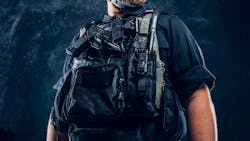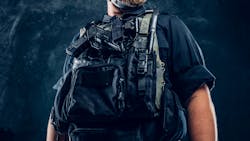The Blurring of Body Armor vs Tactical Wear
If you compared today’s daily uniform wear body armor to that of the 1970s or 1980s, you’d see some pretty big differences. The focus of this article is why those differences are beneficial for both the agencies and the officers and what the past may tell us about the future where body armor is concerned.
Back in the late 1970s and early to mid-1980s, concealed body armor was still growing into common use. Rookies coming out of the academies in the mid-1980s often received criticism from veteran officers who thought only [whimps] wore body armor There was a plethora of criticisms directed toward the body armor itself: It inhibited mobility, restricted arm movement, made the wearer hot and contributed to fatigue.
This article appeared in the January/February issue of OFFICER Magazine. Click Here to view the digital edition. Click Here to subscribe to OFFICER Magazine.
There may have been at least some partial truth to those criticisms. Concealable body armor back then was heavier and less flexible. To achieve the same protective ratings as today’s body armor, the armor of those years had to be thicker and often was sandwiched between sheets of plastic. The armor was susceptible to damage and degradation from moisture and heat. Since the body armor was often worn directly in contact with or close to the skin, sweat— you know, moisture created on a hot body—it was sheathed in thin plastic which could be easily sponged off.In 1987, when the movie RoboCop was released, the patrol officers were wearing external body armor complete with collars, and they regularly wore ballistic helmets as well. One officer, working the streets in the late 1980s said, “Movies predict our future.” Other officers thought he was crazy.
Since that time, the armor that patrol officers wear has evolved. The materials and composites used have been improved so that it takes fewer layers of it to stop the most common ballistic threats law enforcement faces today. It has become more flexible, to the point where the thinnest, NIJ-rated level of protection can almost be wadded up like a t-shirt, then shaken out and put back on. In fact, NIJ-rated ballistic material can be found, at the lowest ratings, woven into something as innocuous as a sweatshirt. (There’s a different conversation to be had about backface deformation, but that’s for another article).
As armor evolved, several different solutions to the discomfort and heat retention were found. There was the focus on making the ballistic material itself thinner and lighter. There were a number of products created with the purpose of creating an air gap between the body armor and the wearer’s body. Some have become popular… some not so much. One of the most notable evolutions was when an armor carrier was created that allowed the “concealed” armor to be wore outside the uniform. Now, how it can be it worn on the outside of the uniform shirt and still be concealed?
The carrier was made to look like a uniform shirt, covering the torso and not having sleeves. It essentially looked like a uniform shirt if you ignored the difference between the material of the armor carrier and the uniform shirt being worn beneath it. The benefit was that having a T-shirt and uniform shirt between the armor and the wearer allowed for less moisture to get onto/into the carrier material. The armor could also be easily taken off when inside a safe area during the summer months, allowing the wearer and the armor to cool off.
At that time, all the officer’s tools and equipment were still being carried on the gunbelt. The badge, name tag, rank and ribbons were worn on the armor carrier. At that point, the benefits being realized by these re-imagined carriers were all related to the armor itself.
Gradually, the external carriers, while still trying to look like a uniform shirt torso, evolved to have the ability to carry a greater number of items. A radio pouch was added to some. Pockets large enough to carry notepads or ticket books were added to others. The colors still matched the uniform shirt (the Navy/utility blue ones anyway), still had faux buttons and still had the metal badge, metal nametag, metal rank and any ribbons pinned on.
In parallel to the armor carrier development, gun belts and holsters were being changed as well. Nylon was becoming more accepted, and less metal/brass was being worn day to day. At the same time, more items were being added to the officer’s daily carry. From the 1970s gun belt carrying a gun, speedloaders/magazines, baton, flashlight, handcuffs and radio to the 2000s gunbelt adding chemical weapon cannister, gloves, EMD (TASER), trauma kit and more, the gunbelt was running out of real estate.
All the while, SWAT team members were wearing “tactical” body armor that allowed them to carry equipment on the vest itself. Why weren’t uniform officers able to do that? There are two reasons that come to mind: 1) Because many chiefs and sheriffs felt that it looked too unprofessional; too relaxed; to unfriendly to the community, and 2) Because for the previous five-plus decades, officers had worn formal attire. The “tactical” vest wasn’t formal in any sense of the word. It was nylon, had webbing, used hook-and-loop for attachments, etc. Finally someone was smart enough to think, “Who cares?”
Officers can (and do) still look professional while wearing external body armor with equipment on it. Instead of metal badges, nametags, rank, etc.—although many still do—Velcro nametapes, embroidered badges and rank are all still present. The benefits of armor that can be easily taken off and put back on as necessary for comfort are all still present, and the relaxing of “formal” appearance standards has allowed more equipment to be put on the vest carrier; equipment like radios, handcuffs, trauma kits, chemical weapon cannisters, batons, EMDs, etc. Moving those items from gun belt to vest has reduced lower back injuries, hip discomfort and, sometimes, personal injury due to an excessive amount of equipment on the belt. Spreading the weight out helps relieve a lot of problems that develop long-term.
The question, and focus of this article, then is: what’s the difference between the daily uniform wear armor and the “tactical” armor of your SWAT team? The simple answer is coverage, threat rating and comfort. While many of today’s uniform external carriers allow for upgrades like hard plates, collars, shoulder wraps and groin extensions, no patrol officer is wearing them (or should be unless they work in a truly high threat environment). SWAT officers are, or can be, wearing all of that on a call out and the hard plates, to increase the threat rating of the armor, is most often present, front and back.
The end result is that the uniform carrier is actually more integrated into the uniform performance, allows for more comfortable armor wear, and contributes to the longterm physical health of the officer. There is no doubt that as uniforms continue to evolve in materials and design, the external uniform armor carriers will do the same. While it may appear that patrol officer uniform are simply “transitioning into SWAT uniforms,” the reality is that common-sense, healthy and safe design is moving the external uniform carrier designs in that direction.
This article appeared in the January/February issue of OFFICER Magazine.
We’d appreciate your feedback on external uniform armor carriers. What would you like to see being done different? What do you feel would add to the utility of them? Send your comments to [email protected].
About the Author
Lt. Frank Borelli (ret), Editorial Director
Editorial Director
Lt. Frank Borelli is the Editorial Director for the Officer Media Group. Frank brings 20+ years of writing and editing experience in addition to 40 years of law enforcement operations, administration and training experience to the team.
Frank has had numerous books published which are available on Amazon.com, BarnesAndNoble.com, and other major retail outlets.
If you have any comments or questions, you can contact him via email at [email protected].


